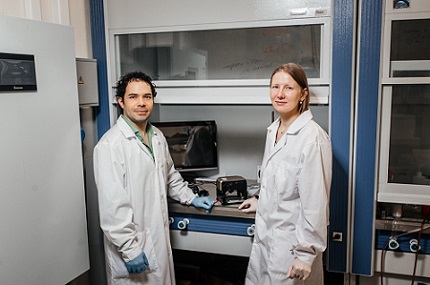TOMSK, Russia, March 8, 2021 — A method that integrates metals into polymers for the formation of electrically conductive composites uses laser pulses to irradiate aluminum nanoparticles onto polyethylene terephthalate (PET) substrates. Researchers from Tomsk Polytechnic University (TPU), with international collaborators, formulated the laser-driven integration method, which has implications for flexible electronics. The process locally formed a conductive composite in irradiated areas.

TPU researchers Raul David Rodriguez Contreras and Evgeniya Sheremet. Courtesy of TPU.
“The development of these technologies requires crucially new materials that exhibit superior mechanical, chemical, and electric stability, comparatively low cost to produce on a large scale, as well as biocompatibility for certain applications,” said Raul David Rodriguez Contreras, a professor in the TPU Research School of Chemistry and Applied Biomedical Sciences.
In that context, he said, polymers and PET are areas of special interest, though conventional methods of polymers modification, to add the required functionality, typically change conductivity of the entire polymer volume. This limits applications for complex topologies of 3-manifolds, he added.
The researchers chose aluminum because it is a cheap and readily available metal. Silver is often used as a conductor for flexible electronics. The researchers used silver as a control to compare their method, as well as graphene-based materials.

“Mechanical stability tests (abrasion, impact, and stripping tests) proved that composites based on aluminum nanoparticles surpass other materials,” said Evgeniya Sheremet, professor in the TPU Research School of High-Energy Physics. “Moreover, the material structure itself turned out to be very interesting.”
The researchers found that aluminum carbide formed on the sample surfaces during the laser processing.
“Furthermore, polymers induce the formation of graphene-like carbon structures. We did not expect this effect,” Sheremet said. “Besides, by adjusting laser power, we can control material conductivity. In practice, using a laser, it is possible to ‘draw’ almost any conductive structure on polymer surface and make it locally conductive.”
The technique posited by TPU implicated only two basic technological steps: the application of nanoparticles onto the polymer surface, and laser processing. The method is also applicable to a variety of additional materials.
The authors of the work describing the method said it can be used for flexible electronics, a field that remains plagued by the low mechanical stability of products. Photocatalysis, flexible sensors for robotics, light-emitting diodes, and biomedical products are among other potential fields of application, the article authors said.
The team plans to test on other materials such as silver, copper, and carbon tubes. It also intends to use a variety of polymers.
Researchers from TPU, the University of Electronic Science and Technology of China, the Leibniz Institute for Polymer Research Dresden, and the University of Amsterdam contributed to the work.
The research was published in Advanced Functional Materials (www.doi.org/10.1002/adfm.202008818).